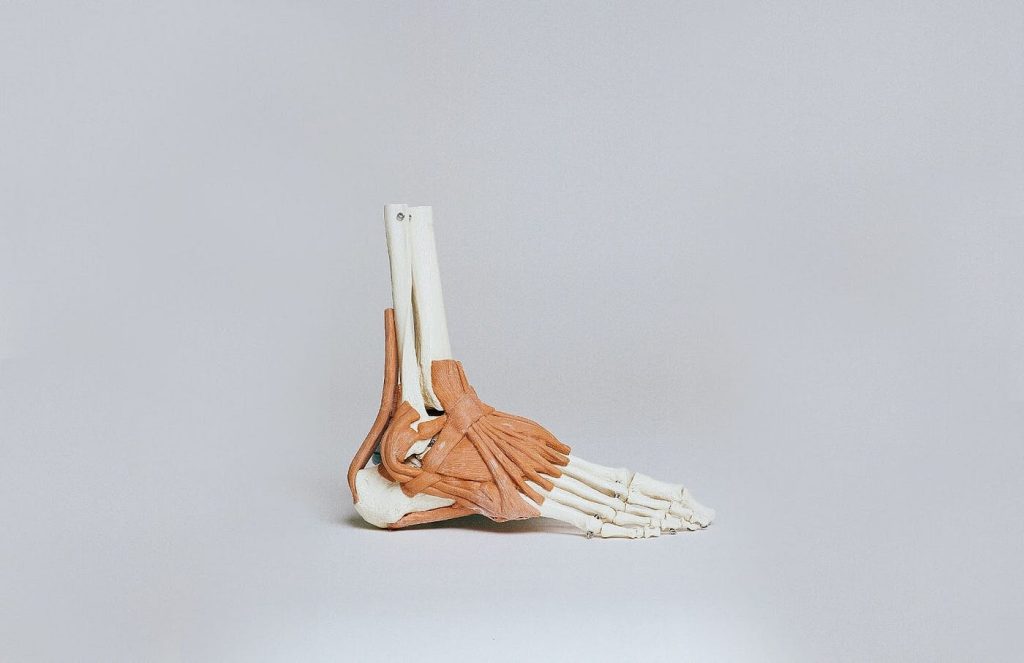
Ankle mobility is needed for multiple movements, including standing, walking, jumping, getting up from a chair, and going up and down stairs. To perform these movements, plantarflexion and dorsiflexion are required. Lack of proper plantarflexion and dorsiflexion can lead to a number of injuries and even result in conditions like foot drop.
What is dorsiflexion and plantarflexion?

Dorsiflexion
The top part of the foot is called the dorsum. When the dorsum of the foot moves towards the body, this movement is called dorsiflexion. When you are sitting with your legs outstretched and you bring your foot and toes towards your body, you are dorsiflexing. Altneratively, when you are sitting in a chair and you raise your foot while your heel is planted on the floor, you are dorsiflexing.
Plantarflexion
The bottom part of the foot is called the plantar surface. When the plantar surface moves away from the body, this movement is called plantarflexion. When you are sitting with your legs outstretched and you point your toes away from your body, you are plantarflexing. And when you are sitting in a chair and you raise your heel while the ball of your foot is planted on the floor, you are plantarflexing. If you are standing on tippy toes, you are plantarflexing.
How do dorsiflexion and plantarflexion occur?
The ankle joint is the articulation of the tibia and fibula in the lower leg and the talus in the foot. The bones are held together by strong ligaments and a joint capsule. These structures provide support and stability to the joint while also allowing movements such as dorsiflexion and plantarflexion.
Movement of the joint can occur in several ways. If you are standing and lean forward against a countertop, as your tibia moves forward, your ankle begins to dorsiflex. In this case, you are not actively bringing the dorsum of your foot toward your body, but bringing your body toward the dorsum of your foot.
When you are stepping into a tub, you most likely contract the muscles that keep your foot and toes up, thus actively dorsiflexing to prevent your foot from hitting the tub.
The same is true of plantarflexion. If you are sitting on your heels, you are not actively plantarflexing, but your ankle is in a plantarflexed position. When you are reaching up high into a cabinet, you contract the muscles in your calf to raise on your toes, thus actively plantarflexing.
Many muscles cross the ankle joint and assist in achieving these movements, along with providing dynamic stability to the joint. The primary dorsiflexor is the tibialis anterior muscle. The primary plantarflexors are the gastrocnemius and soleus muscles.
Ankle mobility and gait
The ability to dorsiflex and plantarflex the ankle during gait is necessary for forward progression and stability.
Active dorsiflexion is important in gait to maintain your foot and toes from plantarflexing with gravity (scraping the ground) during the swing phase of gait and to land on your heel for shock absorption and to roll over the foot as you move forward. The ability of the ankle to dorsiflex during the stance of gait allows your body to progress over your foot. Active plantarflexion is needed at push-off to create a rigid lever and propel the body forward.
That said, it’s not only important to have the strength to dorsiflex and plantarflex during gait but also to have the necessary range of motion in the joint to efficiently progress through all components of the gait cycle.
When range of motion or strength at the ankle is compromised, gait compensations at the knee and hip such as vaulting, circumduction, and knee hyperextension may result. Typically, about 15 degrees of ankle dorsiflexion is the goal.
Factors that can impact dorsiflexion and plantarflexion:
- Weakness
- Spasticity
- Joint stiffness or contracture
- Surgical procedures
- Pain
- Synergy patterns
- Proprioceptive impairments
Can lack of plantarflexion and dorsiflexion cause pain somewhere else?
Yes — a lack of ability to dorsiflex and plantarflex can cause pain outside the ankle. The ankle is the first major joint that absorbs shock when walking, jumping, or running. If there is a loss of ankle mobility, due to limited plantarflexion or dorsiflexion, that shock will need to be absorbed elsewhere. This can contribute to conditions such as Achilles tendonitis, patellar tendonitis, plantar fasciitis, sacroiliac dysfunction, and lumbopelvic muscular imbalances.
As shock absorption is forced onto other joints of the body, it can also contribute to knee pain, hip pain, and even back pain.
Conditions that impact dorsiflexion
Several conditions can impact ankle dorsiflexion. They include:
- Underlying mobility conditions, including cerebral palsy, multiple sclerosis, stroke, and other neurological conditions that impact muscle and nerve function
- Ankle joint restriction, which can result from a tight joint capsule or scar tissue in the joint
- Genetics. In some cases, poor ankle dorsiflexion is caused by a person’s genetics
- Injury. Sprains that have not healed properly and injury to other areas of the lower body, including the leg, hip, and back, can all cause a person to modify the way they walk, thus impacting the ability to properly dorsiflex
- Flexibility deficit, which occurs when calf muscles (known as the Gastroc/Soleus complex) are too tight and lead to restricted movements
- Pain, which can cause changes in gait
Conditions that impact plantarflexion
Problems with plantarflexion, like dorsiflexion, can be caused by a number of conditions and injuries to the ankle joint. They include:
- Conditions that cause plantar flexion contractures, such as cerebral palsy, stroke, sarcopenia, muscular dystrophy, and Charcot-Marie-Tooth disease
- Ankle injuries
- Ankle weakness
- Conditions such as rheumatoid arthritis and osteoarthritis
How to improve plantarflexion and dorsiflexion
If you are struggling to properly plantarflex and/or dorsiflex, exercises and stretches can help improve your strength and range of motion. Always consult with a doctor or physical therapist if you have an injury or mobility disorder before trying a new exercise or stretch.
Exercises to improve plantarflexion strength (pointing toes away from the body) include:
- Resisted Plantarflexion: Sit on a stable surface with your legs straight out in front of you. Place a resistance band around the ball of your foot and hold the ends of the band in your hands. Slowly point your toes away from your body, then return to the starting position.
- Seated Calf Raises: Sit on a chair with your feet flat on the floor. Lift your heels off the ground as high as possible and then slowly lower them back down.
- Standing Calf raises: While standing near a counter or table for balance or support, with your feet hip-width apart rise onto the balls of your feet, then lower back down. This can be done with body weight or while holding a barbell or dumbbell for added weight.
- Ankle hops: Stand on one foot and jump up and down, landing on the balls of your feet.
Exercises to improve dorsiflexion strength (bringing toes towards the body) include:
- Active Dorsiflexion: Sit on a chair with your legs straight out in front of you and your toes pointed downward. With your heels planted on the ground, bring your feet and toes upward off the ground and return to the starting position.
- Resisted Dorsiflexion: Sit on a stable surface with your legs straight out in front of you. Attach a resistance band to a fixed object in front of you, such as a heavy table leg, then loop it over your toes. Start with your toes pointing forward (away from your body), pull your toes toward your body, then return to the starting position.
- Heel Walking: Stand with your back straight and chest up in an upright position. Place your feet shoulder-width apart and slowly lift up your toes off of the ground. If your balance is unstable, hold onto something for support (such as a chair or wall). Keep your hips forward, while your glutes stay tucked in. Walk forward, while keeping your toes raised off the ground
It’s important to note that proper form is crucial during these exercises to avoid injury. Always start with a lower intensity and gradually increase the difficulty level to avoid injury.
Improve plantarflexion and dorsiflexion with the Cionic Neural Sleeve
If you suffer from a severe lack of ankle mobility and experience conditions such as foot drop, exercises can help, but may not be enough to provide you with the function you want. The Cionic Neural Sleeve is an FDA-cleared mobility device designed to improve plantarflexion and dorsiflexion for people with multiple sclerosis, cerebral palsy, and stroke.
In CIONIC’s first multi-site research study, 94% of participants experienced increased ankle dorsiflexion at heel strike. However, ankle dorsiflexion is just part of the story. Many people who experience foot drop also exhibit excessive ankle inversion. This can cause the foot to land on the outside, which increases the risk of falls and injury.
88% of research participants showed an improvement in ankle inversion during swing. If you’re interested in learning more about the Cionic Neural Sleeve and how it can help improve ankle mobility, visit https://cionic.com/neuralsleeve.





